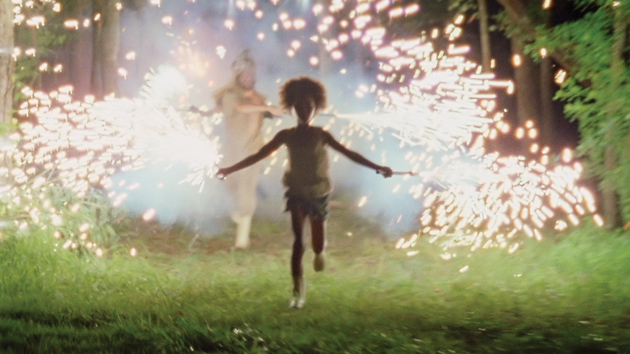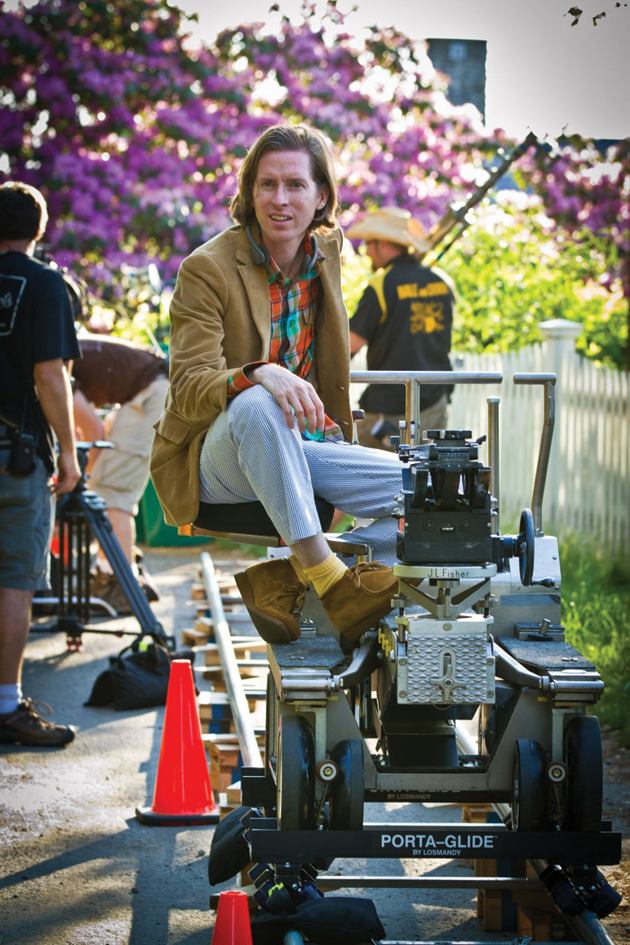The phrase “adventure movie” was food, in childhood, for the most pleasurable kind of anticipation. The excitement wasn’t really ever about the particular exploits, historical or otherwise, that were ostensibly to be celebrated. It had more to do with the prospect of sweeping movements and eye-popping primary colors—of imposing and ever-changing spatial perspectives—of an immersive experience of rivers and canyons and forests, and the opportunity to wander inside half-buried cities or remote encampments. The promise was of dreamlike freedom of movement through a world at once concrete and mysterious—a world shaped for unsupervised play. Two quite remarkable American movies that opened this summer, Beasts of the Southern Wild and Moonrise Kingdom, can be described as adventure movies in the true sense. They breathe an unaccustomed air of freedom and curiosity and what can only be called elation.
Although in other respects as different as can be, they do have certain aspects in common. Each is steeped—Beasts throughout, Kingdom at its climax—in the element of water at its mostly violently uncontrolled. Each lays claim, with an explorer’s attentiveness, to a geographic domain closed off to the outside world. And each is filtered through the consciousness of young leading characters: a six-year-old girl in Beasts, a pair of twelve-year-old runaways in Kingdom. The filmmakers have not gone to children for the sake of their bewildered innocence but for their ferocious clarity of intention and their radiant intelligence not yet reined in or habituated to sullen conformity.
To say that Beasts of the Southern Wild was filmed in southern Louisiana understates the case—it seems like an enormous construction made from pieces of southern Louisiana, and inhabited by the people found there by the film’s young director, Benh Zeitlin, a New Yorker who has been living in New Orleans since 2008. Yet this is no documentary but a work of purest fantasy, set in a world just adjacent to the real and operating with all the liberties of folklore.
We are somewhere south of New Orleans, beyond the levee, on a perpetually endangered floodplain settlement called the Bathtub, a sort of multiracial Eden sustaining itself on wildlife and debris: a loosely linked bayou community below the radar and off the grid. Here the water seeps into everything. We are outside history, outside sociology, caught up straightaway in the territories toward which Huck Finn lit out or in the swamp at the end of the mind, a messy profusion of fiddle music and moonshine. They are wild people living among wild things, unconstrained by laws or walls, reliant on ancient prophecies and herbal cures, at home with the water that may overwhelm them at any moment. It hardly matters whether we are in paradise or perdition. Perhaps it is perdition transmuted by sheer cussedness into paradise. In the floating life of the imaginary, opposites merge with an easy profundity; it’s just what the imaginary is made for.
The waterlogged environment gives Zeitlin a wraparound, ever-present metaphor for the way his film permeates barriers. We soak it up, or dissolve into it. From the start there are rumors of impending flood, apocalyptically couched, as a teacher tattooed with archaic images of aurochs tells her young charges: “Any day now the fabric of the universe is coming unraveled.” In short order we endure storm and deluge, move forward into a future of poisoned waters and prehistoric beasts resurrected from melting ice caps, and return at last to the primal swamp as part of an enduring remnant in a drowned world.
They are us, these survivors, because what Katrina and other hurricanes did to the Gulf Coast can be taken as a foreshadowing of worse to come. The movie is a sort of primitivist-futurist extravaganza made by hand with the fragments of actual disaster. Yet the note sounded throughout is not the terror of catastrophe—although we see the marks of catastrophe on every hand as we glide past submerged and damaged habitations—but the slim exhilarating margin of survival, the dance on the last bare edge of dry ground. (The film, it should be noted—it is Zeitlin’s first feature—was conceived during his long recuperation from a near-fatal car accident.*)
In movies the imaginary tends to be expensive, so independent live-action films generally work with what is already in place and steer clear of the realms of large-scale fantasy. Our dream worlds are elaborated for us by corporate entities with the necessary means. Beasts of the Southern Wild represents a kind of protest against this state of affairs, an assertion of the right to build one’s own make-believe world, with available tools however rudimentary, rather than submitting to the pre-imagined products of Disney, Marvel, Pixar, and the rest. It’s a film made cheaply, and I would imagine sometimes dangerously, with amateur actors and dwellings furnished with the detritus of floods and storms. It makes up its mythology analogously to the way a child might make up a history of the world, with the gaps and unexpected detours and lurching transitions intact.
Advertisement
The child here is Quvenzhané Wallis, an African-American girl who was discovered in a Louisiana elementary school and was six years old when the film was made. It’s hard to imagine what the movie might have been without her. She plays Hushpuppy, whose mother “swam away” (sometimes returning as a disembodied voice) and whose father (played in mingled tones of ferocity and tenderness by a New Orleans baker, Dwight Henry) appears to be dying. Hushpuppy in a sense is the whole movie. What we see is her understanding of how things are—if her father goes missing, it can only be that “daddy woulda turned into a tree or a bug,” and if she listens to animals they tell her what’s on their minds—and it can only be as persuasive as she is.
Everything is mediated through her, on the one hand the unlimited turbulence of the phenomenal world (including the contradictory behavior of a father who in one scene rejects her and in another showers her with love) and on the other hand a child of almost preternatural seriousness and focused energy. The story, as we piece it together, is the perennial fable of the child who must save her father, her community, her world. Accomplishing this involves no magic formula but the mere assertion of will in the face of all terrors, like her father who as the storm descends on them fires a rifle into the raging skies in defiance.
Wallis’s tiny presence is commanding—intense, unflinching, incapable of meek submission—and her manner is far from the winsome ways of most child actors. She is given some large philosophical statements to pronounce—“The entire universe depended on everything fitting together just right”—and by her stance establishes herself as one of those indispensable things on which the universe depends. She is a believable hero because with our own eyes we can see her perform the heroic feat of sustaining an epic film, and in the end accept that her assured glance can indeed (in an image that recalls the world of Maurice Sendak) make predatory beasts kneel before her.
Apply real-world logic and this watery alternate world is in danger of dissolving, like a dream colliding with morning light. When, near the halfway point, a rescue team from the modern world arrives by helicopter to evacuate the residents of the Bathtub and carry them off to a crowded disaster relief center, the movie itself comes uneasily close to losing its delicate balancing of the real and the unreal by a sudden intrusion of inevitable skeptical questions. The rescuers figure as a malevolent intrusive force even though we haven’t been given a clear reason to see them that way. It may well be that flood victims suffering from the effects of exposure and hunger would want nothing more than to escape from the shelter where they are receiving food and medical care in order to return to their flooded homes, but Zeitlin does not do much of anything to show why.
A shot of Hushpuppy in the disaster center wearing an anachronistic Little House on the Prairie–style dress evokes the notion of the wild child “civilized” by well-meaning missionaries, and the center’s ambience is that of an overcrowded and understaffed clinic operating under very disadvantageous circumstances. But the moments when she and the other Bathtub residents flee together from the shelter, racing across a parking lot toward the bus that will take them back home—as if they had been liberated and were on their way to the Promised Land—are the least effectively realized in the movie. We can all recollect the much-reported horrors of the Superdome where survivors were crammed together after Katrina, and Zeitlin may be relying on such recollections, but nothing we see here seems as horrific as it’s evidently meant to be. The shelter has to stand in for the modern world that is otherwise absent from the film, the soulless land only glimpsed from a distance on the other side of the levee.
In the end the film finds a more congenial disaster center in the lake boat that Hushpuppy and some of the other children board in a search for food, with a skipper likewise given to philosophical musings—“This boat’ll take you exactly where you need to be”—and with a turntable that plays only one record, Fats Waller’s “Until the Real Thing Comes Along,” spinning over and over for whores and boatmen as if it were the last record on earth, an oldie dredged up from the flood. This boat of dreams seems almost designed to conjure up the most authentically dreamlike of American movies, Charles Laughton’s The Night of the Hunter, an equally water-soaked work of the imagination.
Advertisement
I wonder if anyone has undertaken a study of Water and Movies. It is a subject of almost infinite application, starting from the earliest registering of the movement of waves and rivulets by cinematic pioneers. Water is the most privileged element in film because it exercises cinematic power merely by being filmed. The bodies of water that have served as crucial staging grounds would make a catalog of the most intense moments in cinema, from the waterfall with which Buster Keaton contended in Our Hospitality to the lotus pool where June Duprez caught sight of John Justin’s reflection in Alexander Korda’s The Thief of Bagdad, from the misty lake across which Kinuyo Tanaka and her children were unwittingly ferried toward misfortune in Mizoguchi’s Sansho the Bailiff to the bay from which James Stewart rescued Kim Novak in Hitchcock’s Vertigo, and on out to the ocean where the doomed hero of Murnau’s Tabu sank beneath the waves. In all that profusion there are some few films where the watery element so predominates as to create a kind of pool for the mind: Jean Vigo’s L’Atalante was one such, Beasts of the Southern Wild is another.
Water is very much present in Wes Anderson’s Moonrise Kingdom, but here the central operating figure is not anarchic bayou but New England coastal island. It is an island bounded by ocean and with wilderness at its core, but kept within some kind of discipline by the forces of social organization that occupy strategic points: lawyers, a police officer, scoutmasters who maintain their troops in good military order, not to mention the visiting representative of a child welfare agency.
The anarchy here is in the hearts of two precocious and socially maladroit twelve-year-olds, Sam (Jared Gilman) and Suzy (Kara Hayward), who find each other against all odds—at an amateur performance of Benjamin Britten’s opera Noye’s Fludde—and carry out a carefully planned getaway into the heart of the island, seeking out the sort of cove that fugitive children dream of: a calm refuge where no adult forces can ever intrude. (The dream of escape pervades Anderson’s films; his first movie, Bottle Rocket, opens with Luke Wilson clambering down a rope of bedsheets to get away from a psychiatric clinic, and a similar rope comes into play in Moonrise Kingdom.)
The movie charts the collision of their desire to evade the world and the world’s insistence on finding them and bringing them under some kind of control—not necessarily out of love (Sam is an unwanted orphan, and Suzy’s parents have other problems on their mind), but in automatic response to the scandalousness of their insistence on being free and independent and, finally, married to each other. There are other adults too, among them the local police chief played by Bruce Willis and the scoutmaster beautifully realized by Edward Norton, more capable of a sympathy that seeps into the film through the tersest of exchanges. Suzy and Sam are at the center of a profuse cast of characters, each of whom has some crucial note to sound and many of whom undergo unexpected evolutions that add continually to the richness of the film’s texture.
Such a bald summary already does injustice to the intricacies of Anderson’s narrative structures, which are as cunningly laid out as Sam and Suzy’s plan of escape. There is a carefully calibrated arrangement and disarrangement of maps and schedules and chronological schemata as the film develops, a narrative trickery both entertaining in itself and filled with the secretive pleasures of childish game-playing, with its hideouts and disguises and encoded maps. Anderson’s obsession with hermetic structures mirrors that of his characters, who carefully contain themselves within constructed worlds, whether it’s the sprawling labyrinth of a home inhabited by Suzy’s lawyer parents (Bill Murray and Frances McDormand) or the frontier stockade that serves as the headquarters of the Khaki Scouts of North America.
All human habitations in Anderson’s films tend to have the quality of grotesque and unnatural excrescences, all the more so here in contrast to the wooded crags and rocky streams of the inner island. Sam, a misfit despised by his fellow scouts and disowned by his foster parents, is a master of camping skills adept with map and compass. Crossing a field in a coonskin cap as he steals away from Camp Ivanhoe—while on the soundtrack Hank Williams sings his tragic ballad of the lovelorn wooden Indian “Kaw-Liga”—he seems like the perfect embodiment of the values imparted by, say, Fess Parker as Davy Crockett, except that he has arrived too late.
Suzy, who alternates between immersion in young adult novels about magical orphans and violent outbursts against her parents and her schoolmates, carries the modern world (the movie is set in 1965) with her in the form of a portable record player and a single Françoise Hardy recording. (The alternation, throughout the film, of the music of Benjamin Britten, Hank Williams, and Françoise Hardy, along with a stirring original score by Alexandre Desplat, is not incidental but central to its meanings.)
Sam and Suzy are inventing the world as they go along, word by word and gesture by gesture. Wes Anderson’s antinaturalism here becomes precisely the only convincingly naturalistic way to express the love story he has imagined. The stylized dialogue in which his characters tend to address each other—and which some viewers have always found wincingly mannered—has never seemed more appropriate than as a lingua franca for alienated twelve-year-olds who, on top of everything else, must invent a way to communicate with each other. Each brings a certain amount of special knowledge and a certain number of sacred childhood objects to the process, and the extraordinary care with which they negotiate these transfers of information is a measure of how much they care.
Their tentative dance down by the cove to the music of the portable record player is a scene of tenderhearted and melancholy intelligence, all the more so for being at the center of what is after all a comedy, and at times a broad one. The boisterousness of the film’s finale, with its sieges and rescues, its lightning bolts and flash floods, relieves what would otherwise be an almost unbearably sad evocation of what is least preservable about youthful experience: not so much the loss of that “innocence” which is such a hackneyed motif of modern American culture (and for which summer camps have always been a favored location), but the awakening of the first radiance of mature intelligence in a world liable to be indifferent or hostile to it, an intelligence that can conceive everything and realize only the tiniest fragment of it.
The respect that Anderson has for his young characters is the essence of Moonrise Kingdom, a film that finds a path through material that in other hands would more likely have sunk into a morass of sentimentality. But then pathfinding is the film’s central action. Sam earns his coonskin cap by turning the island’s creeks and woods into a heroic landscape. The inevitable question is what world or life he could possibly be in training for. None that exists, any more than the worlds of which Suzy reads in her beloved fantasy novels. The books and their cover art are artifacts created for the film, like so many of the objects in Anderson’s films. He shares with Jacques Tati and with few contemporaries I can think of the desire to build everything, even the most ordinary objects, afresh.
To make a world where everything looks newly made is part of the great adventurousness of his work, and in Moonrise Kingdom the effect, by juxtaposition, is to make even the rocks and creeks look new. It is perhaps the only setting in which Sam and Suzy could begin to articulate their goal: “to go on adventures and not get stuck in one place.”
This Issue
September 27, 2012
Pride and Prejudice
Cards of Identity
Are Hackers Heroes?
-
*
See Scott Foundas, “Louisiana Story,” Film Comment, May/June 2012. ↩





